In the intricate maze that is manufacturing, we sometimes forget the Bill of Materials or BOM. However, it is a crucial gear that makes the whole machine work better. It supercharges production and guides businesses towards victory. So, let us dive into why BOM is a must-have in any manufacturing journey.

Key Takeaways
- BOM (Bill of Materials) is a detailed list of all parts and materials needed to make a product.
- Knowing about BOM is key for planning production, managing inventory, and controlling costs.
- BOM ensures all parts are on hand, cutting down on delays and problems in production.
- Good BOM management boosts productivity, lowers costs, and makes customers happier.
- BOM tools and templates make creating and managing BOM easier, helping businesses of any size.
Understanding BOM Meaning and Its Significance
A Product Parts List (PPL) is vital for creation. It details every piece and resource that goes into a product. This ensures we are prepared and have the correct quantities during the production process.
What is a Bill of Materials (BOM)?
A BOM, or Bill of Materials, is like a recipe. It tells us all the bits and pieces we need to make a product. Tiny stuff. Big stuff. It is all on their. This cool list helps people make stuff without forgetting anything. Makes things run smoothly.
Why is a BOM Crucial in Manufacturing?
The BOM plays a major role for many reasons. It checks that everything necessary is set, avoiding hold-ups. Through listing all materials and quantities, it aids in figuring out costs. This helps manufacturers to better arrange their finances. It also assists in monitoring quality to confirm that products are manufactured correctly. Thanks to a thorough BOM, manufacturers can perform more effectively, maintain less stock, and produce top-notch items. The BOM is an essential instrument for overseeing production, making companies more productive and profitable.
BOM Meaning: Exploring the Components of a BOM
Think of a bom (bill of materials) as a recipe for making a product. It lists all the ingredients, in our case, parts and materials, required. So, how does a bom look like and what does it contain? It is simple! Every bom has unique part numbers at its heart. Think of these as tags for different components. They team up with descriptions that tell us more about each part. Then there is the quantity field, telling us the count of every part, and the unit of measure, spelling out whether we’re counting in pieces or pounds.

Knowing where to get parts and materials is critical. That is what supplier info in a bom does. This is an immense help for manufacturers. It helps buy needed stuff effectively and keeps the supply flowing. Boms may contain cost info too. Plus, points like lead times, and logistics data for planning and budgeting. When you know what is in a bom, you can improve production. Less waste and timely delivery of excellent quality stuff. Software or a template, no matter what. Understanding what is in a bom is authentic for mastering manufacturing.
BOM Management: Streamlining the Process
Handling materials’ bills (BOMs) well is crucial for controlling manufacturing. The strategic BOM handling enables businesses to operate effectively, minimize errors, and reduce production costs. Unique software aids in facilitating BOM handling.
BOM Software: Simplifying BOM Management
BOM software is a great tool for handling bills of materials. It automates tasks like making, updating, and sharing BOMs. This makes the entire process smoother and more precise. With it, companies can keep all their product data in one place, making sure everyone has the latest info.
The same tools mesh perfectly with different systems, such as ERP (Enterprise Resource Planning) and CAD software. This allows for seamless data transition, reducing errors and enhancing team constructive collaboration. The use of bom software eliminates unnecessary effort and time spent in maintaining BOMs. Consequently, businesses can pay greater attention to other vital aspects of product creation.
Handling bom tasks is growing tricky, making bom software crucial. This digital aid eases the process, letting companies see the big picture. It keeps manufacturers nimble, resilient, and in the game in a rapidly shifting market.
BOM Examples and Templates
We will explore some actual instances of materials’ bills (BOMs) and the advantages of employing BOM templates. These instruments assist firms in streamlining their production and guaranteeing their products are assembled correctly.

Real-life BOM Examples
Cars and laptops share something in common – a BOM. In car-making, a BOM is an extensive list. It lists every part: the engine, tires, seats, even the dashboard. This is not just a list; it is a plan. It guides what parts to get and how the car gets assembled. Now, let usus talk about laptops. Their BOM also lists parts. These include the motherboard, processor, RAM, storage, and display. Accuracy in this list matters. It ensures the right parts are used and assembled properly.
BOM Template: A Handy Tool
Several producers’ resort to BOM templates for the ease of crafting and overseeing BOMs. Such templates furnish a standard design for itemizing materials and components required. They are adjustable, catering to diverse arenas and commodities, rendering them a handy instrument. Utilizing a BOM template enhances corporate efficiency, reduces error probability, and stimulates productivity. Tracking stock, preparing for elements, and confirming readiness becomes simpler. This paves the way for rapid production, minimal surplus, and a more streamlined operation.
Conclusion
The Bill of Materials (BOM) is key to making things. It helps businesses know what they need to make a product. This includes parts, materials, and how they fit together. By using a BOM, companies can make things better, cut down on mistakes, and make sure their products are top-notch.
We looked at what the BOM is, why it matters, and its parts. We also talked about how managing a BOM well helps. Using special software can make managing a BOM easier. This helps businesses use their BOM better to succeed in making things.
The BOM is a vital tool for planning and improving how things are made. It helps with making things more efficient, saving money, and making customers happy. By using what we learned here, companies can make the most of their BOM. This can take their manufacturing to the next level. For more information about BWISE, feel free to schedule a demo. Remember B1 – BWISE
